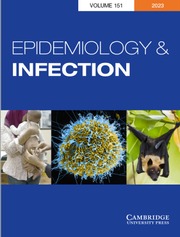Crossref Citations
This article has been cited by the following publications. This list is generated based on data provided by
Crossref.
Worsfold, Denise
1995.
Recipe for food safety.
Nutrition & Food Science,
Vol. 95,
Issue. 6,
p.
22.
Boyce, T. G.
Koo, D.
Swerdlow, D. L.
Gomez, T. M.
Serrano, B.
Nickey, L. N.
Hickman-Brenner, F. W.
Malcolm, G. B.
and
Griffin, P. M.
1996.
Recurrent outbreaks ofSalmonellaEnteritidis infections in a Texas restaurant: phage type 4 arrives in the United States.
Epidemiology and Infection,
Vol. 117,
Issue. 1,
p.
29.
Evans, M. R.
Tromans, J. P.
Dexter, E. L. S.
Ribeiro, C. D.
and
Gardner, D.
1996.
Consecutive salmonella outbreaks traced to the same bakery.
Epidemiology and Infection,
Vol. 116,
Issue. 2,
p.
161.
Scott, E.
1996.
Foodborne disease and other hygiene issues in the home.
Journal of Applied Bacteriology,
Vol. 80,
Issue. 1,
p.
5.
McDermid, A.S.
and
Lever, M.S.
1996.
Survival of Salmonella enteritidis PT4 and Salm. typhimurium Swindon in aerosols.
Letters in Applied Microbiology,
Vol. 23,
Issue. 2,
p.
107.
Rejnmark, Lars
Stoustrup, Ole
Christensen, Inge
and
Hansen, Anders
1997.
Impact of Infecting Dose on Severity of Disease in an Outbreak of Food-borne Salmonella enteritidis.
Scandinavian Journal of Infectious Diseases,
Vol. 29,
Issue. 1,
p.
37.
Mead, G. C.
and
Scott, M. J.
1997.
Spread of an enteric ‘marker’ organism during evisceration of New York dressed poultry in a simulated kitchen environment.
British Poultry Science,
Vol. 38,
Issue. 2,
p.
195.
Jones, M.V.
1998.
Application of HACCP to identify hygiene risks in the home.
International Biodeterioration & Biodegradation,
Vol. 41,
Issue. 3-4,
p.
191.
Oosterom, Johannes
1998.
The importance of hygiene in modern society.
International Biodeterioration & Biodegradation,
Vol. 41,
Issue. 3-4,
p.
185.
Rusin, P.
Orosz-Coughlin, P.
and
Gerba, C.
1998.
Reduction of faecal coliform, coliform and heterotrophic plate count bacteria in the household kitchen and bathroom by disinfection with hypochlorite cleaners.
Journal of Applied Microbiology,
Vol. 85,
Issue. 5,
p.
819.
Scott, Elizabeth
1999.
Hygiene issues in the home.
American Journal of Infection Control,
Vol. 27,
Issue. 6,
p.
S22.
Gibson, LuAnn L.
Rose, Joan B.
and
Haas, Charles N.
1999.
Use of quantitative microbial risk assessment for evaluation of the benefits of laundry sanitation.
American Journal of Infection Control,
Vol. 27,
Issue. 6,
p.
S34.
Tebbutt, G.M.
1999.
Comparison of traditional and rapid methods for assessing the risk of bacterial cross-contamination from cutting boards.
International Journal of Environmental Health Research,
Vol. 9,
Issue. 1,
p.
67.
DUFF, STEVEN B.
MAFILIOS, MICHAEL S.
and
ACKERMAN, STACEY J.
2000.
Economic evaluation of infection control practices in day care and the home: methodologic challenges and proposed solutions.
The Pediatric Infectious Disease Journal,
Vol. 19,
Issue. Supplement,
p.
S125.
SURESH, T.
SRINIVASAN, D.
HATHA, A.A.M.
and
LAKSHMANAPERUMALSAMY, P.
2000.
The Incidence, Antibiotic Resistance and Survival of Salmonella and Escherichia coli Isolated from Broiler Chicken Retail Outlets..
Microbes and Environments,
Vol. 15,
Issue. 3,
p.
173.
SCOTT, ELIZABETH
2000.
Relationship between cross-contamination and the transmission of foodborne pathogens in the home.
The Pediatric Infectious Disease Journal,
Vol. 19,
Issue. Supplement,
p.
S111.
Hilton, A.C.
and
Austin, E.
2000.
The kitchen dishcloth as a source of and vehicle for foodborne pathogens in a domestic setting.
International Journal of Environmental Health Research,
Vol. 10,
Issue. 3,
p.
257.
Sharp, Kay
Haysom, Iain
and
Parkinson, Rosamund
2001.
Anti‐microbial hand washes for domestic use – their effectiveness in vitro and in normal use.
International Journal of Consumer Studies,
Vol. 25,
Issue. 3,
p.
200.
Chen, Yuhuan
Jackson, Kristin M.
Chea, Fabiola P.
and
Schaffner, Donald W.
2001.
Quantification and Variability Analysis of Bacterial Cross-Contamination Rates in Common Food Service Tasks.
Journal of Food Protection,
Vol. 64,
Issue. 1,
p.
72.
Sockett, Paul N
and
Rodgers, Frank G
2001.
Enteric and foodborne disease in children: A review of the influence of food- and environment-related risk factors.
Paediatrics & Child Health,
Vol. 6,
Issue. 4,
p.
203.


